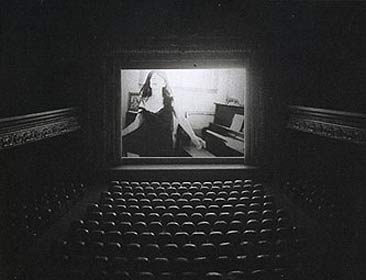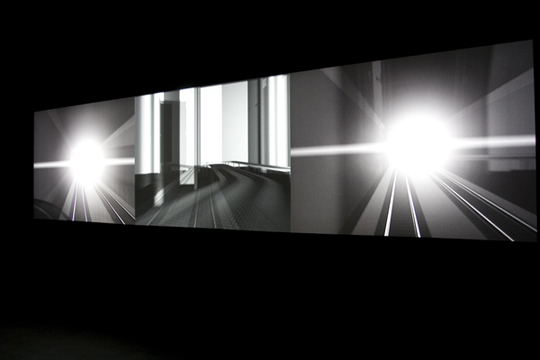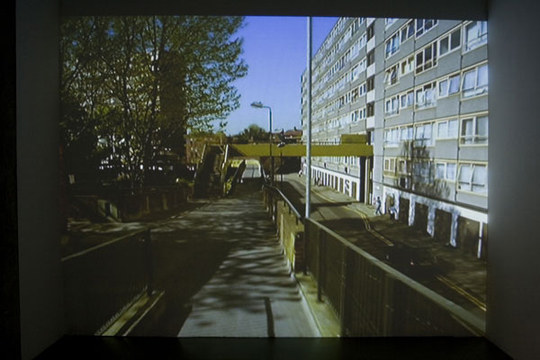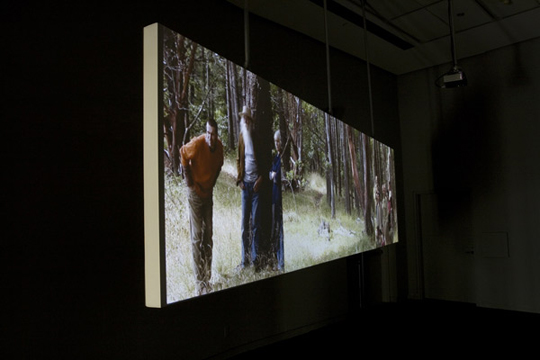
April 9 - June 17, 2007
Curated by Barbara Fischer
Co-presented with the Justina M. Barnicke Gallery
At BLACKWOOD GALLERY:
Nestor Krüger, Mark Lewis & Judy Radul
At JUSTINA M. BARNICKE GALLERY:
David Askevold, Rebecca Belmore, Genivieve Cadieux, Janet Cardiff & George Bures Miller, Ian Carr-Harris, Christine Davis, Stan Douglas, Murray Favro, Wyn Geleynse, Rodney Graham, David Hoffos, Kelly Mark, John Massey, Nathalie Melikian, Gar Smith, Michael Snow, Jana Sterbak, Robert Wiens & Krzysztof Wodiczko





Projections is a major survey of projection-based works in the history of contemporary art in Canada from the mid-1960s to the present. Organized by the Justina M. Barnicke Gallery (Hart House), the exhibition is co-produced and presented by the three other major galleries of the University of Toronto: the Blackwood Gallery (Mississauga campus), the Doris McCarthy Gallery (Scarborough campus), and the University of Toronto Art Center (St. George campus).
Work by Nestor Krüger, Mark Lewis, and Judy Radul, is exhibited at the Blackwood Gallery.
Opening Reception
Thursday April 8, 1-6pm
Justina M. Barnicke Gallery, Hart House
The exhibition brings together for the first time the particularly rich area of experimentation with slide, film, and video projection that characterizes over four decades of contemporary art in Canada. For most of the artists presented in the exhibition, projection has been a major aspect and a defining concern over many years, such as for Michael Snow and Murray Favro; it may even constitute an ar tist’s entire practice, such as for Stan Douglas or David Hoffos. In other instances, projection is part of a larger body of work in diverse media ranging from sculpture to sound and photography, such as it is for Geneviève Cadieux, Janet Cardiff & George Bures Miller, Jana Sterbak, Rebecca Belmore, and Robert Wiens, among others. Some of the works presented in this exhibition are internationally recognized as seminal in the history of contemporary art, and most will be shown in Toronto for the first time, including works by David Askevold, Ian Carr-Harris, Nestor Krüger, Jana Sterbak, and newly commissioned works by Nathalie Melikian and Kelly Mark. Together these works encapsulate a history that exemplifies and provides insight into why projection has become such an important and prevalent medium.
In this exhibition, projection is both a medium and a subject. Realized in the form of sculpture, slide-dissolves, 16mm film, and video, the works exploit both the experiential and the metaphoric potential of projection as an analog for seeing, imagining, dreaming, and knowing. Some works underplay and others exceed the synchronized, integrated, or immersive effects of the most dominant manifestation of projection in contemporary culture: cinema. If cinema haunts the exhibition, its powers are suspended and its effects disentangled. Instead of presenting a strict chronology, the exhibition focuses attention on par ticular cinematic forms as they are taken apar t to emphasize the conceptual implications of their components, which are reflected in the structure of the exhibition. At the University of Toronto Art Centre, some works focus our attention exclusively on the experience of light, reflection, and illumination. Others point to the paradoxical nature of the screen, where a text or image is cast to show the colouring or shaping of a variously receptive and resistant surface that takes part in constructing perception. Works presented at the Justina M. Barnicke Gallery more explicitly inhabit the forms of cinema. They newly engage and playfully dissociate the relationships bet ween voice and image, the camera’s eye and the viewer’s body, and the construction of cinematic spectacle. Finally, works presented at the Blackwood Gallery and the Doris McCarthy Gallery share the projection of travels and journeys into recorded and therefore virtual space, while irreverently undermining the illusions and utopian dimensions of this projected place.
In earlier works the emphasis is on isolating and parsing specific experiential effects, whereas in more recent works a flowering of new cinematic and spatial reconfigurations demonstrates our entanglement in mediation. In all cases, however, the interest of the ar tists is in the way projection allows us to look at how the world is seen—however distorted, strangely recognized, or poignantly observed. Projection in contemporary art in Canada serves less as a means to tell a story than as a means of thinking through ideas about seeing and knowing, and of experimenting with the conceptual, psychological, and political dimensions of the relationship bet ween the two—which is where the history of this work joins the analyses of mediation that have themselves been a powerful force in the intellectual legacy in this country.
- Barbara Fischer